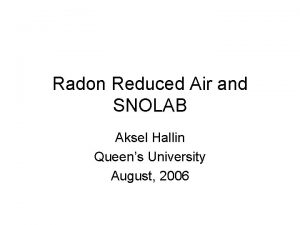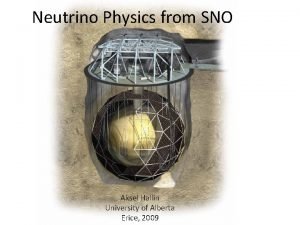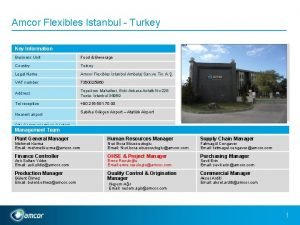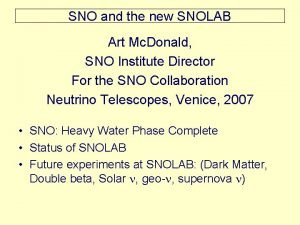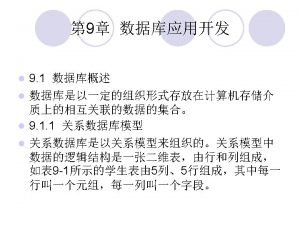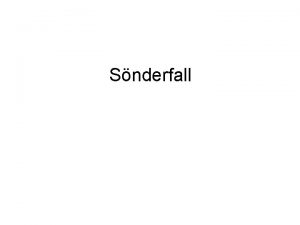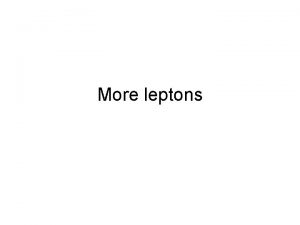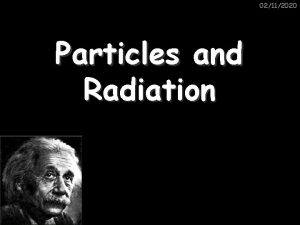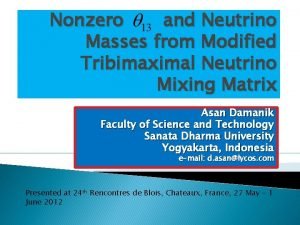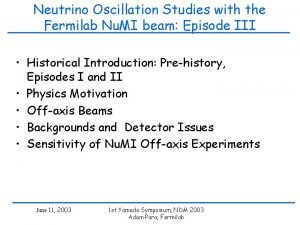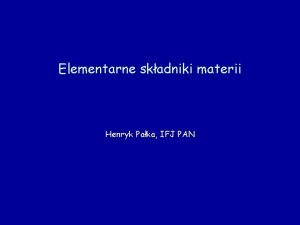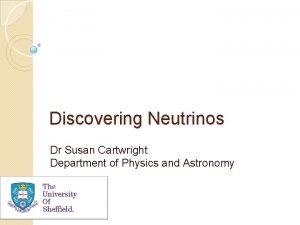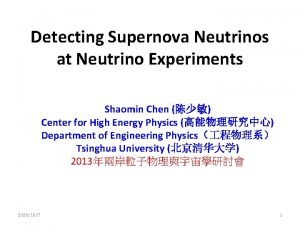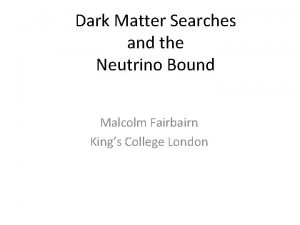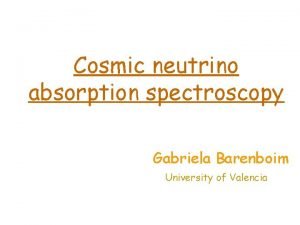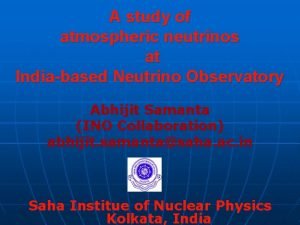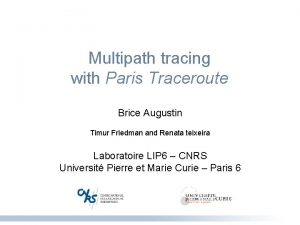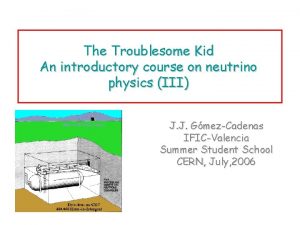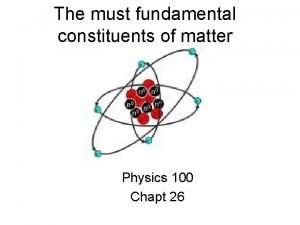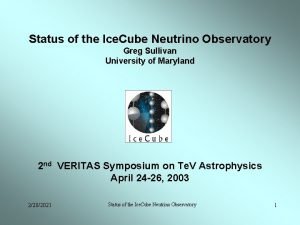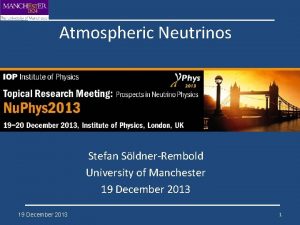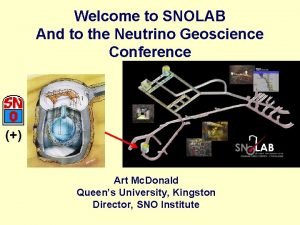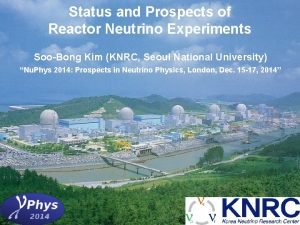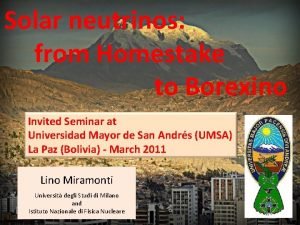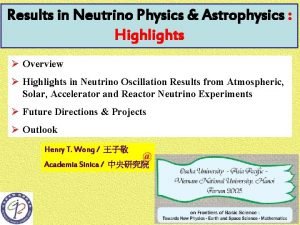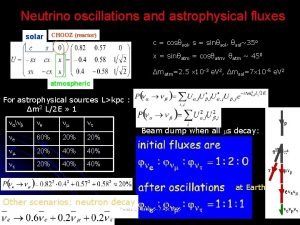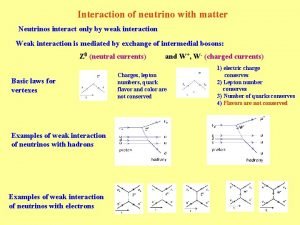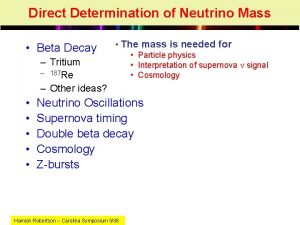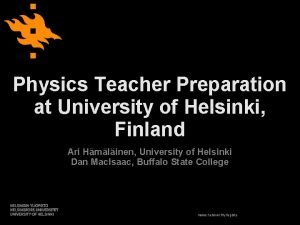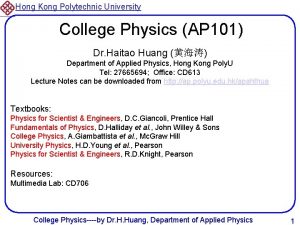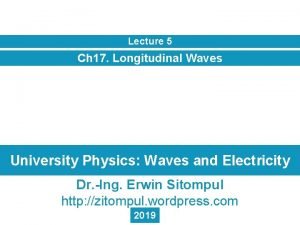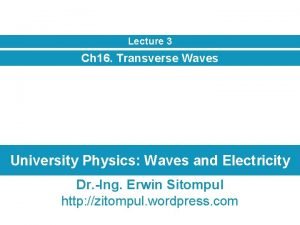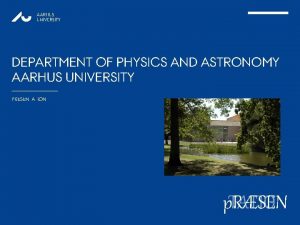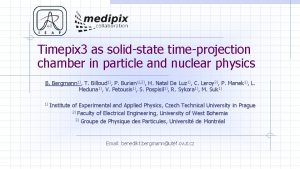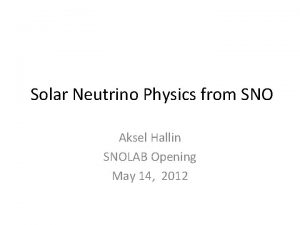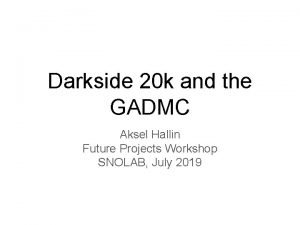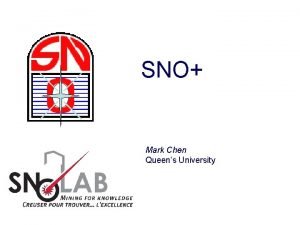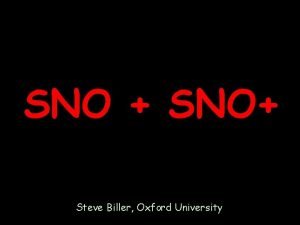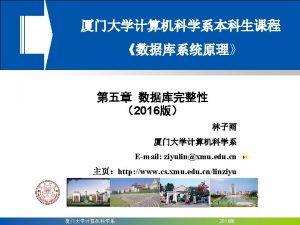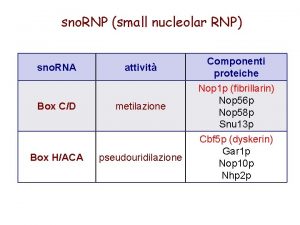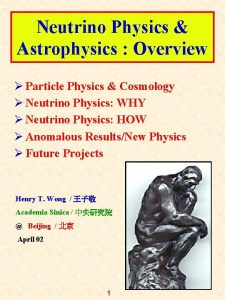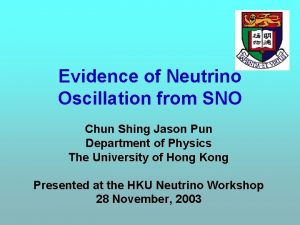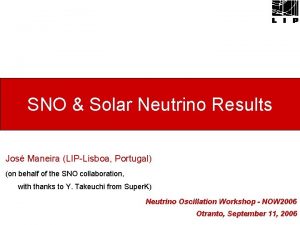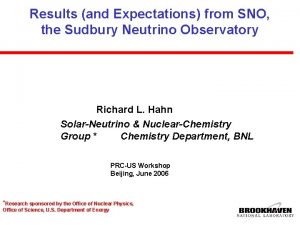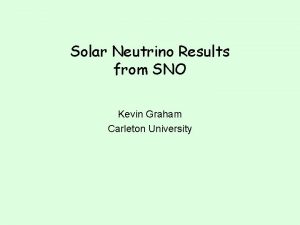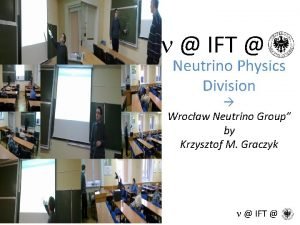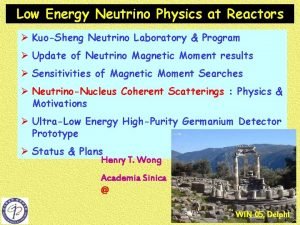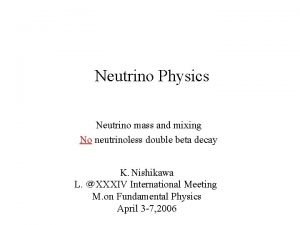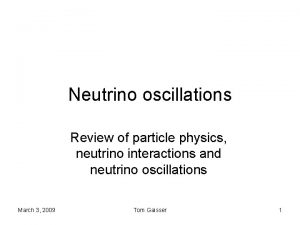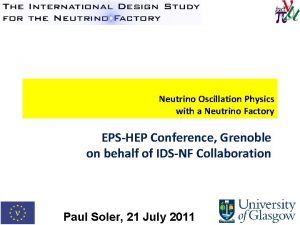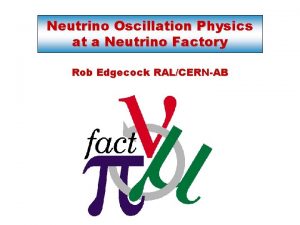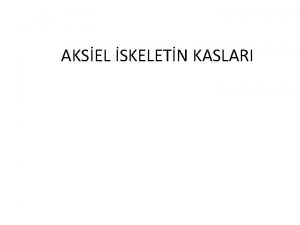Neutrino Physics from SNO Aksel Hallin University of








































- Slides: 40

Neutrino Physics from SNO Aksel Hallin University of Alberta Erice, 2009

Neutrino Physics from SNO/SNO+ • SNO+ will be discussed by Christine Kraus and Simon Peeters; also Art Mc. Donald. • SNO 3 Phase analysis by N. de Barros

Neutrino-Electron Scattering (ES) Charged Current (CC) 1000 tonnes D 2 O Support Structure for 9500 PMTs, 60% 12 mcoverage Diameter Acrylic Vessel Neutral (NC) 1700 Current tonnes Inner Shielding H 2 O 5300 tonnes Outer Shield H 2 O Urylon Liner and Radon Seal Sudbury Neutrino Observatory

Three Phases of SNO: 3 NC reactions ü Phase I: Just D 2 O: neutron capture on deuterium • Simple detector configuration, clean measurement • Low neutron sensitivity • Poor discrimination between neutrons and electrons üPhase II: D 2 O + Na. Cl: neutron capture on Chlorine • Very good neutron sensitivity • Better neutron electron separation • Phase III: D 2 O + 3 He Proportional Counters • Good neutron sensitivity • Great neutron/electron separation

Solar n Measurements Ø Global Summary

SNO • n n Ended data taking 28 Nov 2006 Most heavy water returned June 2007 Finish decommissioning end of 2007 TRIUMF Town Meeting 1 -3 August 2007

Current SNO Efforts • High frequency periodicity studies (solar g-modes) • Burst searches • Exotics (e. g. , n-nbar oscillation) • 3 -Phase analysis including NCD pulse shape analysis and hep analysis • Low Energy Threshold Analysis (LETA) Joint Phase I+II down to Teff>3. 5 Me. V Significantly reduced systematics Direct ne survival probability fit (Borexino and Super-K also working in this regime) SNO trigger threshold <~2. 0 Me. V for all phases Previous SNO analysis thresholds: T>5. 0 Me. V/5. 5 Me. V/6. 0 Me. V Phase I/II/III

Physics Motivations for Low Threshold Analysis Ø MSW (Matter Effect) Phenomenology `Unlucky’ Parameters Lar ge sp ec tra ld ist ort ion s(nm, t) = 0. 155 s(ne) /Night y a D e g r a L Pee Rise of survival probability at low Tn as we approach vacuumaverage value of 1(1/2)sin 22 q Eu hep-ph/0305159 effect

Physics Motivations for Low Threshold Analysis ( also SNO+ ) Nonstandard effects can be enhanced by MSW-like resonance Miranda, Tortola, Valle, hep-ph/0406289 (2005) M. C. Gonzalez. Garcia, P. C. de Holanda, E. Masso and R. Zukanovich Funchalc, hep-ph/0803. 1180 Friedland, Lunardini, Peña-Garay, PLB 594, (2004) Barger, Huber, Marfatia, PRL 95, (2005)

Physics Motivations for Low Threshold Analysis • Test the model of massive neutrino mixing • Kam. LAND+Solar provides (weak) handle on q 13

Advantages of Low Threshold Analysis Ø ne Statistics En=6 Me. V

Advantages of Low Threshold Analysis Ø nx (NC) Statistics Phase I (D 2 O) NC +74% Phase II (D 2 O+Na. Cl) NC +68%

Advantages of (2 -Phase) Low Threshold Analysis Ø Breaking NC/CC Covariance Phase I (D 2 O) “Beam Off” Phase II (D 2 O+Salt) “Beam On”

Challenges of a Low Threshold Measurement Ø Low Energy Backgrounds Cosmic rays < 3/hour Teff>3. 5 Me. V All events (before background reduction); ~5000 ns

Challenges of a Low Threshold Measurement Ø Low Energy Backgrounds PMT b-gs Old threshold Kinetic Energy Spectrum 3 neutrino signals + 17 backgrounds internal (D 2 O) external (AV + H 2 O) New Threshold = 3. 5 Me. V NC+CC+ES (Phase II) MC

How Do We Make a Low Threshold Measurement? To make a meaningful measurement, we: • Reduced backgrounds • Reduced systematic uncertainties • Fit for all signals and remaining backgrounds Entire analysis chain re-done, from charge pedestals to simulation upgrades to final `signal extraction’ fits Primary reasons for improvement in precision: 1. Increased statistics 2. Breaking of NC/CC covariance 3. Reduction in systematic uncertainties

Low Energy Threshold Analysis ØSignal Extraction Fit (Signal PDFs) Not used Teff (Me. V) (R/RAV)3 1 D projections cosqsun

Low Energy Threshold Analysis ØSignal Extraction Fit (3 Background PDFs) Teff (Me. V) (R/RAV)3 1 D projections cosqsun

Low Energy Threshold Analysis ØSignal Extraction Fit (3 signals+17 backgrounds)x 2, and pdfs are multidimensional: ES, CC NC, backgrounds Two distinct methods: 1. Maximum likelihood with binned pdfs: Manual scan of likelihood space (iterative) • Locate best fit and +/- 1 s uncertainty data helps constrain systematics • `human intensive’ 2. Kernel estimation---ML with unbinned pdfs: • Allows full `floating’ of systematics, incl. resolutions • CPU intensive---use graphics card!

Low Energy Threshold Analysis Ø Background Reduction New energy estimator includes both `prompt’ and `late’ light Rayleigh Scatter 12% more hits≈6% narrowing of resolution ~60% reduction of internal backgrounds New Cuts help reduce external backgrounds by ~80% Example: High charge early in time Fiducial Volume β γ β (it was good we fixed our pedestals…)

Low Energy Threshold Analysis ØSystematic Uncertainties • Nearly all systematic uncertainties from calibration data-MC • Upgrades to MC simulation yielded many reductions • Residual offsets used as corrections w/ add`l uncertainties • All uncertainties verified with multiple calibration sources

Low Energy Threshold Analysis ØSystematic Uncertainties—Energy Scale No correction With correction 16 N calibration source 6. 13 Me. V gs Volume-weighted uncertainties: Old: Phase I = ± 1. 2% Phase II = ± 1. 1% New: Phase I = ± 0. 6% Phase II = ± 0. 5% (about half Phase-correlated) Tested with: Independent 16 N data, n capture events, Rn `spike’ events…

Low Energy Threshold Analysis ØSystematic Uncertainties—Position Old New Central runs remove source positioning offsets, MC upgrades reduce shifts Fiducial volume uncertainties: Old: Phase I ~ ± 3% Phase II ~ ± 3% New: Phase I ~ ± 1% Phase II ~ ± 0. 6% Tested with: neutron captures, 8 Li, outside-signal-box ns

Low Energy Threshold Analysis ØSystematic Uncertainties—Isotropy (b 14) MC simulation upgrades provide biggest source of improvement Tests with muon `followers’, Am-Be source, Rn spike b 14 Scale uncertainties: Old: Phase I --- , Phase II = ± 0. 85% electrons, ± 0. 48% neutrons New: Phase I ± 0. 42%, Phase II =± 0. 24% electrons, +0. 38%-0. 22% neutrons

Low Energy Threshold Analysis ØPMT b-g PDFs Not enough CPUs to simulate sample of events Use data instead Pass Fail. Pass `Bifurcated’ analysis NPF = e 1(1 -e 2)Nb In-time ratio NFP = (1 -e 1) e 2 Nb NFF = (1 -e 1)(1 -e 2)Nb NPP = e 1 e 2 Nb + Ns Early charge probability Pass. Fail NFF NPMT= NPP – Ns = NFP * NPF / (so fixing pedestals gave us a handle on these bkds…) In-time ratio

Low Energy Threshold Analysis Ø Analysis Summary • Fits are maximum likelihood in multiple dimensions (two methods) • Most PDFs generated with simulation • Systematics from data-MC comparisons • In some cases, corrections applied to MC PDFS based on comps. • Tested on multiple independent data sets • 208 Tl • PMT pdf generated from bifurcated analysis of data • Tested on MC and with independent analysis using direction vs. R 3 • Dominant systematics (6/20) allowed to vary in fit • Constrained by calib. • Note: many backgrounds look alike! But very few look like signal • Some backgrounds have ex-situ constraints from radiochm. assays

Low Energy Threshold Analysis Ø Full Fit to Data (1 D projection, binned) Phase II fit c 2 = 13. 5 / 15 PRELIMINARY

Low Energy Threshold Analysis Ø Full Fit to Data (1 D projection, binned) Phase. III fit Phase PRELIMINARY

Low Energy Threshold Analysis Ø Full Fit to Data (1 D projection, binned) Phase II cosqsun ES signal visible even at 3. 5 Me. V threshold c 2 = 3. 0 / 7 PRELIMINARY

Low Energy Threshold Analysis Ø Full Fit to Data (1 D projection, binned) Phase I cosqsun PRELIMINARY

Low Energy Threshold Analysis Ø Uncertainties on ES Electron Recoil Spectrum Salt phase spectrum PRELIMINARY

Low Energy Threshold Analysis Ø Uncertainties on ES Electron Recoil Spectrum Salt phase spectrum LETA spectrum PRELIMINARY

Low Energy Threshold Analysis Ø Uncertainties on ES Electron Recoil Spectrum Statistics (+ bkg correlations) Detector systematics PRELIMINARY

Low Energy Threshold Analysis Ø Uncertainties on CC Electron Recoil Spectrum Salt phase spectrum PRELIMINARY

Low Energy Threshold Analysis Ø Uncertainties on CC Electron Recoil Spectrum Salt phase spectrum LETA spectrum PRELIMINARY

Low Energy Threshold Analysis Ø Uncertainties on CC Electron Recoil Spectrum Statistics (+ bkg correlations) Detector systematics PRELIMINARY

Low Energy Threshold Analysis Ø Uncertainties on CC Electron Recoil Spectrum Phase II PRELIMINARY Phase III Phase I+II

Low Energy Threshold Analysis Ø SNO-Only Mixing Parameters (Without Day/Night)

Low Energy Threshold Analysis Ø Results to Look for in Upcoming Paper Pasym Pavg • CC & ES binned recoil spectra • NC-measured total flux • Direct extraction of survival probability Pee: • Solar+Kam. LAND two-flavor contours • Solar+Kam. LAND three-flavor contours E n En

Summary • Low Energy Threshold Analysis nearly complete • Expect significant improvements in precision • Many other SNO analyses also finishing up
 Aksel hallin
Aksel hallin Aksel hallin
Aksel hallin Fatmagül cengaver
Fatmagül cengaver Oregon nordic club
Oregon nordic club Mc sno
Mc sno Bennett pass sno park
Bennett pass sno park Xsxx sex
Xsxx sex University physics with modern physics fifteenth edition
University physics with modern physics fifteenth edition Dotterkärna
Dotterkärna Leptons
Leptons Emission spectrum of sodium
Emission spectrum of sodium Neutrino
Neutrino Neutrino
Neutrino Lekka cząstka elementarna mion elektron lub neutrino
Lekka cząstka elementarna mion elektron lub neutrino Who discovered neutrino
Who discovered neutrino Neutrino
Neutrino Neutrino
Neutrino Gabriela barenboim
Gabriela barenboim Neutrino
Neutrino Paris traceroute
Paris traceroute Neutrino
Neutrino Neutrino symbol
Neutrino symbol Neutrino
Neutrino Neutrino
Neutrino Solar neutrino
Solar neutrino Neutrino
Neutrino Solar neutrino
Solar neutrino Solar neutrino
Solar neutrino Neutrino mass
Neutrino mass Neutrino
Neutrino Neutrino interaction with matter
Neutrino interaction with matter Neutrino mass
Neutrino mass Modern physics vs classical physics
Modern physics vs classical physics Example physics ia
Example physics ia Helsinki university physics
Helsinki university physics University physics
University physics University physics
University physics University physics
University physics University physics
University physics Aarhus university physics
Aarhus university physics University physics
University physics
